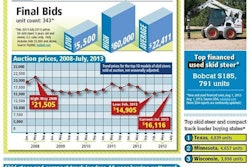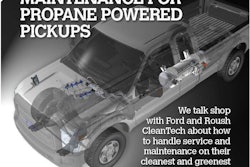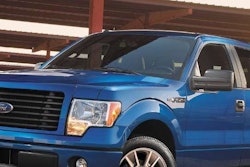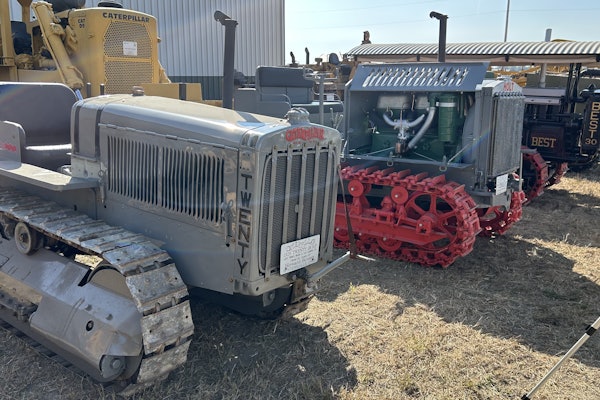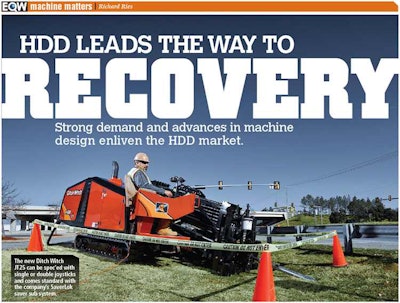
If there’s a bright spot in our murky economic recovery, it is horizontal directional drilling. HDD, strong for several years, is likely to remain a bright spot for some time. There have been adjustments in the market based on machine size and new vs. used, but the overall health remains, driven primarily by sewer, water and energy. And after years of proven performance, HDD has come to be accepted as the preferred method for installation of underground structures.
“The energy sector is as good as it’s ever been,” says Richard Levings, director of product management at American Augers, acquired by Ditch Witch last year. “Higher prices and new technology have opened up areas in this sector that were once unrecoverable economically.” Levings says that running primary electric is also in high demand, especially for longer bores of 8,000 to 10,000 feet and up to 24 inches in diameter.
Josh Beddow, product marketing manager for Toro, which bought the Astec line last year, says there is a significant rebound in the horizontal directional drilling market, specifically in units under 50,000 pounds. “We’re seeing pre-recession industry sales numbers in many categories with more than 10 percent compounded annual growth rate since 2009. We believe a large part of that increase is being driven by continued growth in telecom with demand for faster, cheaper broadband and expanded coverage to rural areas.”
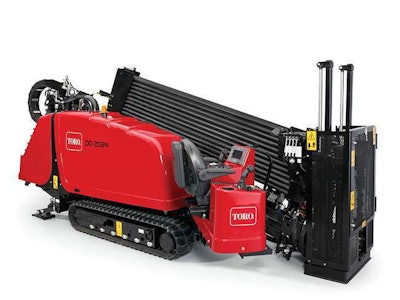 Toro’s new entries into the HDD market, including the DD2024, will sport the company’s familiar red paint.
Toro’s new entries into the HDD market, including the DD2024, will sport the company’s familiar red paint.Meeting this demand is a host of new machines that make the most of modern designs in engines, electronics, and hydraulics. They pack maximum performance into the smallest possible package.
American Augers’ offerings concentrate on larger HDDs, starting with the 110,000-pound DD-110. Levings says there have been significant changes to these machines. Electronics, electrohydraulics, and telematics that have become common on smaller drills are making inroads into larger machines. And he says bigger machines are becoming more mobile. They’re faster and easier to set up and take down and they have lower weights and smaller dimensions to make them easier to transport.
Even with smaller machines the demand is for power and performance from a smaller footprint, according to Randy Rupp, director of product definition at Ditch Witch. Improvements in engines and hydraulics have made it possible to meet these requirements.
HDD contractors, however, continue to struggle with a shortage of qualified operators and clients who mandate increasingly stringent management of drilling fluid. OEMs are taking steps to make it easier for new operators to quickly come up to speed and contractors are developing new ways to manage mud.
Operator shortage in some sectors
Levings says the operator shortage has not been felt in the larger drill sector – primarily because there are fewer machines in this size classes. That’s less true for owners of smaller directional drills, where higher numbers of machines create a need for more operators.
Jon Kuyers, global product manager for the underground segment at Vermeer, says the solution to the shortage has two components. First, machines are becoming more user friendly with improved electronics, more intuitive interfaces, and standardization of controls within a family of machines. Second, contractors can get quality training. While simulators are available and some community colleges offer courses, on-the-job training is best, he says. “There are too many variables that can’t be replicated with a simulator or in the classroom, and on-the-job training exposes the trainee to the soil types the contractor encounters every day.”
 Vermeer’s D100x140 Navigator, designed for water, sewer and gas pipeline work, has maximum rotation speeds up to 200 rpm.
Vermeer’s D100x140 Navigator, designed for water, sewer and gas pipeline work, has maximum rotation speeds up to 200 rpm.Beddow agrees new hires require OTJ training but notes there are limits to the ease and efficiency of doing so. A big part of improving training is improving the machines to make them both more versatile and intuitive, he says. Some drills can perform automated processes, but Beddow says that automated operation isn’t practical for contractors in most situations. “Operators prefer to have more control and flexibility to make adjustments according to the job site needs.”
Toro-built HDDs are available with single or double joystick controls. A single stick can be faster in some conditions while two sticks improve control in more challenging conditions. The new Ditch Witch JT25 can also be spec’ed with single or double joysticks, a feature the company says it will consider including on new machines as they are developed.
Standard on the JT25 is Ditch Witch’s new SaverLok saver sub system. A saver sub is the attachment point for drill rods. It protects the threads of the drive unit from wear associated with frequent addition and removal of rods. Replacing a saver sub with worn threads is much less expensive than repairing worn threads on the drive unit. “The SaverLok design makes our saver sub quicker and easier to install than other types,” Rupp says, “allowing change-outs in as little as two minutes with no need for a thread-lock compound or the curing time such compounds require. This results in significant reductions in downtime.” The SaverLok system will be available by the end of 2013 for all Ditch Witch drill units of 12,000 pounds pullback and higher.
Managing mud
Management of drilling fluid has become one of the most difficult aspects of directional drilling. Much of this is in response to pressure from the public. “Even though drilling fluid is inert with no risk of negative environmental impact, public perception is that everything is toxic,” says Levings. “It borders on hysteria.”
From procurement to recovery to re-use and disposal, every aspect of fluid management is critical. The biggest concern is that there be no “inadvertent returns.”
“The energy sector is as good as it’s ever been.”
Such returns are usually in the form of fracking out, where the pressurized fluid seeks the path of least resistance instead of following the bore annulus back to the point of entry where it can be contained and recovered. Fracking out often results in mud emerging on the surface. Levings says that many job specs now require 100 percent containment and proper disposal. Contractors and project owners work out the disposal issue before the job begins.
Reclaimers are used to recondition used drilling fluid after it emerges from the bore. Cuttings are removed and the fluid is restored to its proper viscosity. Kuyers cautions that reclaimers require proper setup but can have a strong positive effect on profitability. “Reconditioning drilling fluid on site for reuse reduces transportation costs. Reconditioning also keeps sand content low, preventing premature wear of high pressure pump liners and mud motors.” He says that he’s started seeing contractors using viscometers more often to check the viscosity of drilling fluids. “In general, contractors are having to get smarter about fluid. As bores become more complex it’s no longer a matter of one-size-fits-all with drilling fluid.”
While HDD operators in Europe routinely use Marsh funnels, operators in the United States still rely on intuition and experience, “sticking their hands in the mud to see what it feels like,” Rupp says, adding either method can be effective.
Wire line and walk-over both have their place
With improved electronics, walk-over tracking systems are offering better performance. They’re more precise than older models, less affected by external factors, and detect drill heads at greater depths. But wire line systems are impervious to radio frequency and electromagnetic interference and provide tracking in places where walk-over would be difficult or impossible.
“In our business everybody uses wire line,” says Levings of the large drill segment. “The people who own the pipe want to know where it is.” He says that the longer, deeper bores made by owners of American Augers equipment are beyond the reach of walk-over locating systems.
Wire line is sometimes spec’ed by the asset owner, such as a pipeline or utility, says Kuyers. This is especially true on multi-day drills where concerns about battery life in the sonde of a walk-over system come into play. If the tracking method isn’t specified by the customer, Kuyers says it’s up to the contractor to “understand the dynamics of the bore, identify challenges, and develop strategies for working through those challenges.”
Finding good used drills
The used HDD market is in the throes of some unusual circumstances. Rupp notes that prior to the recession many machines were shipped out of the country. In 2008 and early 2009, manufacturers cut back significantly on production. The result is that the inventory of late-model used machines is low at a time when demand is high.
HDD Broker has served as intermediary between sellers and buyers of used directional drilling equipment since the company started in 2000. General manager Bob Martin says that in the aftermath of the recession “very few contractors were buying new equipment” and that used equipment offers a safe, lower-cost alternative to new. “Buying used equipment allows contractors to expand their fleets and capabilities while controlling costs.” He says ongoing stability in the market has led to cautious optimism that has buyers looking at new machines once again.
Used machines in the 20,000- to 30,000-pound class are in highest demand and are popular with start-ups due to their versatility, according to Martin. He advises contractors “not get caught up in buying locally. It’s a different marketplace and a changing world that’s full of opportunities.” With Internet access to global listings, third-party equipment inspection, and professional transport services, there’s no reason to restrict one’s search to nearby sellers. Martin estimates the global market for used machines is about 1,000 units per year.
MTI, a division of The Charles Machine Works, also buys used directional drills from contractors. The company inspects equipment and performs routine preventive maintenance based on the operating hours accrued. The machines are then put through one or more test drills to assess performance and functionality. Service work indicated during the test drill(s) is performed before the unit is sold. “We caution contractors in the market for used drills that you can’t always judge a unit by the hours or how it looks,” says Kevin Smith, MTI Equipment general manager. “By doing inspections, maintenance and additional repairs according to what we discover during test drills, we can offer buyers peace of mind in their purchasing decisions.” EW




